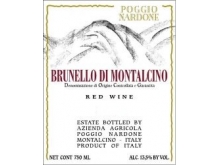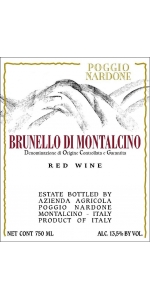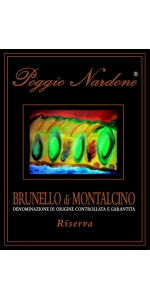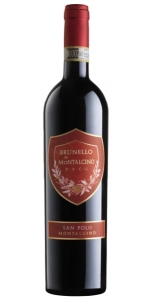Poggio Nardone Brunello di Montalcino 2011
| Country: | Italy |
| Regions: | Tuscany Brunello di Montalcino |
| Winery: | Poggio Nardone |
| Grape Type: | Sangiovese |
| Vintage: | 2011 |
| Bottle Size: | 750 ml |
Poggio Nardone Brunello di Montalcino is made from 100 percent Sangiovese Grosso.
The rich nose displays scents of spices combined with aromas of small red ripe fruits, blackberry and blueberry.
Well structured, determined and elegant, with round and silky tannins. Very nice finish.
Alcoholic fermentation was done in tank, malolactic fermentation in oak barrels. Wine was then aged for 3 years in French oak barrels.
Review:
Powerful and classic, it alternates in the best way the floral features of magnolias, gardenias and hawthorn with fruity notes reminiscent of plums, pressed blueberries and lemon juice. Medium-full body, smooth and relaxed in the sip, it closes harmonious and balanced. How beautiful! Better from 2024.
Raffaele Vecchione - WinesCritic.com 94 Points
A ruby red garnet color, ripe fruit aromas, dried fruits, hints of licorice and scents of vanilla. Robust and harmonious in the mouth, a rich texture. The wine is only produced in the best vintages.
The grapes are coming from a vineyard planted at 400 meters above sea level. The soil is mainly marl and limestone.
The density of vines per hectare is 5,000 plants, which is equivalent to 2,000 vines per acre.
The pruning technique used is cordon
The grapes used are 100% Sangiovese grosso
Alcoholic fermentation was done in tank, while the Malo-Lactic fermentation was carried in oak barrels.
Wine was then aged for one year in big French oak barrels and 3 years in Slavonian oak barrels.
Review:
Rich and very slender in the sensory profile alternating notes of black prunes, blackberries, sandalwood, incense, camphor, withered white flowers and vetiver. Hints of woodland undergrowth animate the secondary scene giving it a dark character. Full bodied, soft tannins and a solidly performing finale. Better from 2024.
Raffaele Vecchione - WinesCritic.com 93 Points
Poggio Nardone Brunello di Montalcino is made from 100 percent Sangiovese Grosso.
The rich nose displays scents of spices combined with aromas of small red ripe fruits, blackberry and blueberry.
Well structured, determined and elegant, with round and silky tannins. Very nice finish.
Alcoholic fermentation was done in tank, maloactic fermentation in oak barrels. Wine was then aged for 3 years in French oak barrels.
Review:
Noble and decidedly balsamic in the primary profile alternating notes of peppermint, eucalyptus, green tea leaves and guaranà. A lot of very delicate dried cherries are housed in the background giving brilliance and crunchiness. Medium bodied, well extracted mature tannins and a finale which squeezes from the centre palate onwards. Better from 2025.
- WinesCritic.com 93 Points
Poggio Nardone Rosso di Montalcino is 100 percent Sangiovese Grosso.
Intense ruby red color with garnet tints.
Intense and delicate aromas of fresh fruits with notes of cherry.
Dry red wine with a good strength and freshness, along with a nice aromatic persistence.
The 5 hectares of specialized vineyards in Montalcino are at an altitude of 350 meters above sea level and are surrounded by woodlands of ilex, oak and arbutus which are characteristic of Montalcino’s hillside habitat. The soil is predominantly composed of marl and limestone which renders this terrain particularly rich in mineral salts.
Pairs well with pasta prepared with meat sauces, mushrooms or truffles; complex rice, main courses of pork or veal with sauces.
Review:
"Aromas of red fruit, rosemary and white smoke. Medium-bodied with bright acidity. Pleasant, savory herbs on the palate. Wet-stone finish. Drink now."
- James Suckling (September 2021), 90 points
Poggio San Polo Podernovi Brunello di Montalcino is made from Sangiovese.
Intense ruby red in color with garnet hues, clear and glossy. The bouquet exhibits typical aromas of violets and small red berries. Subtle nuances of forest undergrowth, aromatic wood, a touch of vanilla and jammy mixed fruit then give way to subtle hints of coffee. This Brunello is intense, persistent, broad and heady. Full-bodied and warm on the palate, with a densely-woven texture and robust body, it has a persistent finish with well-rounded tannins. The particular features of the terroir at San Polo produce a Brunello with a capacity for lengthy aging, while patient cellaring enhances the wine during ageing in the bottle.
Review:
Lovely purity of fruit with ultra fine tannins and depth, finesse and complexity. Black cherries, cedar and some flowers. It’s full-bodied with very fine tannins that drive the finish. Give it a year or two to open more, but already so enticing. Drink or hold.
-James Suckling 96 Points
The San Polo 2015 Brunello di Montalcino Riserva (with 8,000 bottles produced) is a textured wine with hearty fruit and touches of smoked meat and spice. At its core, the wine offers dark fruit, blackberry and ripe plum. The rich fruitiness of the wine cedes to campfire ash, mahogany and furniture wax. These results are sultry and even a bit flashy, with distant background tones of teriyaki and plum sauce. The wine is fermented in cylindrical oak fermenters and aged in oak for three years. We'll see this bottle hitting the market sometime after February 2021.
-Wine Advocate 95 Points
All older vintage wines have been purchased from a single collectors cellar. Pictures can be requested before shipment.
Poggio Nardone Brunello di Montalcino is made from 100 percent Sangiovese Grosso.
The rich nose displays scents of spices combined with aromas of small red ripe fruits, blackberry and blueberry.
Well structured, determined and elegant, with round and silky tannins. Very nice finish.
Review:
"This lively red exhibits cherry, strawberry, eucalyptus, tobacco and mineral flavors. The firm tannins work in tandem with the bright acidity, leaving a long, refreshing finish that echoes the fruit, earth and savory elements. Best from 2018 through 2028. 3,800 cases made. — B.S."
- Wine Spectator's Advance (June 15th 2016), 93 points
The Poggio Nardone Estate
The estate Poggio Nardone has been founded in 1996 by Tiziano and Alessandra that, having found some manuscripts down their grandfather in which it wrote of this old place where the wine-dresser produced wine, they have tried to recreate it with their experience matured in the family estate.The estate Poggio Nardone is partially situated in the both the southwest of Montalcino as well as in the area of Montiano near the coast of the Maremma Toscana.
"A tiny estate making classically styled Brunello with consistent quality; the wines have great balance and complexity." - Anthony Dias Blue's pocket guide to wine 2006
The Poggio Nardone Vineyard
The 5 hectares of specialized vineyards in Montalcino are at an altitude of 350 meters above sea level and are surrounded by woodlands of ilex, oak and arbutus which are characteristic of Montalcino’s hillside habitat. The soil is predominantly composed of marl and limestone which renders this terrain particularly rich in mineral salts.
The 3 hectares in the Maremma are situated at an altitude of 220 meters above sea level on a plot of land formed primarily of sandstone and quartz reefs. These vineyards are west facing, and are therefore well ventilated by Mediterranean sea breezes.
Poggio Nardone’s modest size is such that the producer, with care and expertise, can thoroughly dedicate attention to every detail of the estate’s production.
- back
Tenuta di Nozzole La Forra Chianti Classico Riserva is made from 100% Sangiovese.
Located north of the village of Greve in the heart of the Chianti Classico region, the Nozzole estate covers a striking, rugged, mountainous area of about 1,000 acres at 984 feet in elevation. In order to obtain concentration and complexity in the wine, yields are kept low. The grapes are hand harvested, destemmed and crushed. Fermentation is initiated on the skins in temperature-controlled stainless steel tanks, followed by a maceration period to draw out color and tannins. The wine is racked into stainless steel tanks for malolactic fermentation before aging in oak vats and in bottle before release. The wine is bottled on the estate.
The 2020 vintage was characterized by a basically cold period between April and May and by a generally warm and dry climate until July. The initial slight delay of the vegetative cycle has been recovered since the summer. The sudden increase in temperatures, especially for the later varieties where the fruit set had not yet ended, has favored a production characterized by sparse and light bunches. The stable and sunny climate of the months of August and September allowed the grapes to complete ripening in optimal conditions.
- A classic, traditional Chianti from the Folonari family, making wine since the 1700s
- Matured in oak barrels
- Estate bottled, from a highly regarded estate
Review:
Attractive on the nose with cherries, red berries, dried herbs and baking spices. It’s medium-bodied with fine tannins. Harmonious and poised with a refined character. Weightless and agile. Polished and succulent finish.
-Wine Enthusiast 93 Points
Oumsiyat Chardonnay is made from 100 percent Chardonnay.
Intense aromas of luscious tropical fruit notes of ripe peach and pineapple are refreshingly balanced on the palate through to a clean and zesty finish.
RS: 2 g/L
The Chardonnay grapes were sorted prior to vinification to ensure the fruit was healthy and ripe. The grapes were then pressed, and the must was racked to stainless steel fermentation tanks, where the must was fermented at 14 to 16°C with selected yeasts. The wine did not undergo malolactic fermentation to maintain the crisp, fresh style. The wine rested on its fine lees for three months adding texture and subtle complexity before being gently filtered and bottled.










